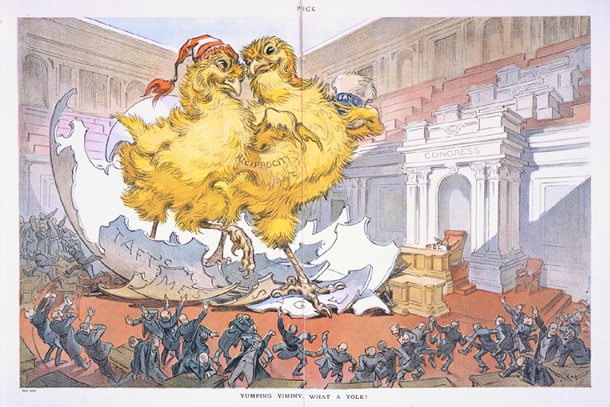
| Title | Yumping Yiminy, What A Yolk! |
| Artist/Maker | Unidentified |
| Date | 1911-04-12 |
| Medium | Lithograph, color |
| Dimensions | h. 11.50 x w. 17.50 in. (h. 29.2 x w. 44.5 cm) |
| Credit Line | U.S. Senate Collection |
| Accession Number | 38.00976.001 |
This hand-colored lithograph was published in an early 20th century issue of Puck magazine. In the cartoon, two giant chicks emerge from an egg amongst a crowd of outraged men. A closer look reveals the words "CANADA" and "US" on the hats of both chicks and "RECIPROCITY" written across their chests. The egg shell represents "TAFT'S MESSAGE" that has just "hatched" in a chamber of "CONGRESS." The image depicts the controversial tariff for trade reciprocity with Canada that was championed by President Taft, and was hotly debated by the Senate in 1910-1911.
At the time, Canada was exporting a high amount of agricultural and raw products, and needed manufactured goods. The U.S. produced the manufactured goods that Canada needed, as well as provided a market for their agricultural and raw products. In January 1911, a treaty was presented to Congress that lowered the tariff on American manufactured goods in return for reducing the tariff of Canadian unprocessed goods. One problem with this agreement was that the U.S. also had a yearly agricultural surplus. Senator Nelson Wilmarth Aldrich, of Rhode Island, supported the tariff believing that trade reciprocity would benefit both countries with minimal effect on U.S. farmers. Senator Albert Jeremiah Beveridge, of Indiana, noted that U.S. farmers would be negatively effected while the U.S. manufacturers would profit from Canada's high demand for manufactured goods. An increasing number of Senators including William O’Connell Bradley of Kentucky, Jacob Harold Gallinger of New Hampshire, William Pierce Frye of Maine, and Reed Smoot of Utah, also opposed the treaty. Despite Republican opposition, Taft cooperated with the southern Democrats whose crops would not be affected to pass the treaty.
Modern political cartoons use symbolism and caricatures to depict politics with succinct sarcasm. They were popularized by Thomas Nast in Harper's Weekly newspaper in the mid-nineteenth century. His drawings inspired the donkey and elephant representations of the Democratic and Republican parties. Other newspapers like Frank Leslie's Illustrated Newspaper, Puck, and Judge followed in a similar fashion to bring pictorial satires to the public at large. The Puck cartoon shown here was recently added to a Senate Collection that contains 340 unique political cartoons from the late 1800s and early 1900s.